This is Baroque Rome in all
its Theatrical Glory, a collection of curvaceous architecture and
elaborate fountains by the era’s two greatest architects, Bernini and
Borromini, and churches filled with paintings by the likes of Caravaggio
and Rubens. The street plan was largely overhauled by 16th- to
18th-century popes attempting to improve the traffic flow from St
Peter’s – in fact, a 19th-century plan to turn Piazza Navona into a
boulevard from Prati across Ponte Umberto I was only killed when wiser
heads widened Corso del Rinascimento instead. However, ancient Rome does
peek through in the shape of Piazza Navona and the curve of Palazzo
Massimo alle Colonne. This is also a neighbourhood of craftsmen,
shopkeepers and antiques restorers and dealers who line Via dei Coronari
(see Antiques Shops).
More recently the narrow alleys around Via della Pace have become a
centre of Roman nightlife, with tiny pubs, trendy cafés and nightspots
where the clientele spills out into the streets in summer (see Chic Cafés and Bars).
|
During the Renaissance, the most strident voices against political scandal and papal excess came from statues. Rome’s statue parlanti
“spoke” through plaques hung around their necks by anonymous wags
(although Pasquino was known to be a local barber). Pasquino’s
colleagues included Marforio , Babuino on Via del Babuino and “Madama Lucrezia” on Piazza San Marco.
|
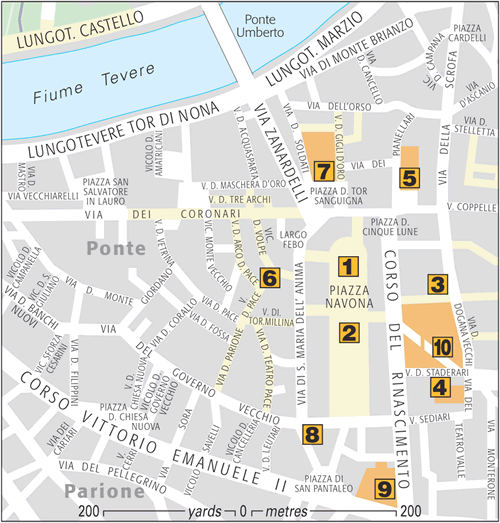
SightsPiazza Navona One of Rome’s loveliest pedestrian squares
is studded with fountains and lined with palaces, such as the Pamphilj,
the church of Sant’Agnese, and classy cafés such as Tre Scalini (see Tre Scalini).
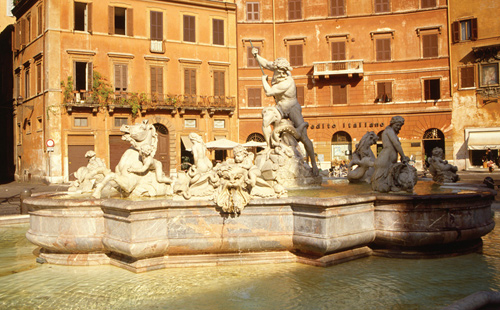
Piazza Navona
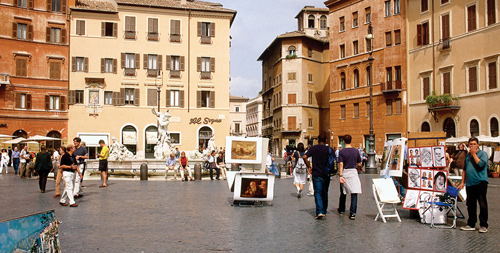
Piazza Navona
Four Rivers Fountain The
statues ringing Bernini’s theatrical 1651 centrepiece symbolize four
rivers representing the continents: the Ganges (Asia, relaxing), Danube
(Europe, turning to steady the obelisk), Rio de la Plata (the Americas,
bald and reeling), and the Nile (Africa, whose head is hidden since the
river’s source was then unknown). The obelisk, balancing over a
sculptural void, is a Roman-era fake, its Egyptian granite carved with
the hieroglyphic names of Vespasian, Titus and Domitian.
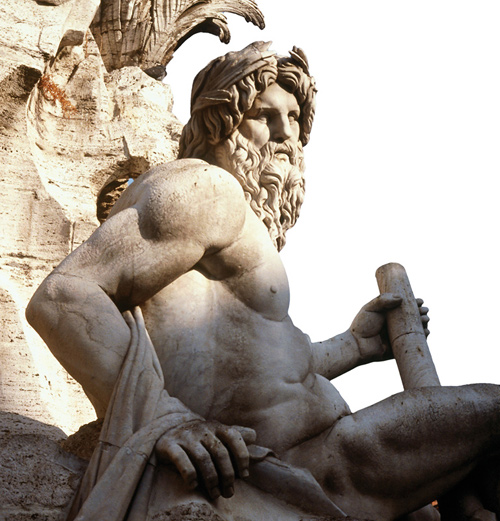
The Ganges, Four Rivers Fountain
San Luigi dei Francesi France’s
national church in Rome has some damaged Domenichino frescoes (1616–17)
in the second chapel on the right, but everyone bee-lines for the last
chapel on the left, housing three large Caravaggio works. His plebeian,
naturalistic approach often ran foul of Counter-Reformation tastes. In a
“first draft” version of the Angel and St Matthew,
the angel guided the hand of a rough labourer-type saint; the
commissioners made the artist replace it with this more courtly one . Underlying sketches in Martyrdom of St Matthew and Calling of St Matthew show how Caravaggio was moving away from symbolic compositions in favour of more realistic scenes. Sant’Ivo Giacomo
della Porta’s Renaissance façade for the 1303 Palazzo della Sapienza,
the original seat of Rome’s university, hides the city’s most gorgeous
courtyard. The double arcade is closed at the far end by Sant’ Ivo’s
façade, an intricate Borromini interplay of concave and convex curves.
The crowning glory is the spiralling ellipse of the dome. The interior
disappoints despite its Pietro da Cortona altarpiece. When the courtyard
is closed, you can see the dome from Piazza Sant’ Eustachio. Corso Rinascimento 40 Courtyard: open 8am– 8pm Mon–Fri, 9am–noon Sun Church: open 10am–4:30pm Mon– Fri, 10am–1pm Sat, 9am–noon Sun Free
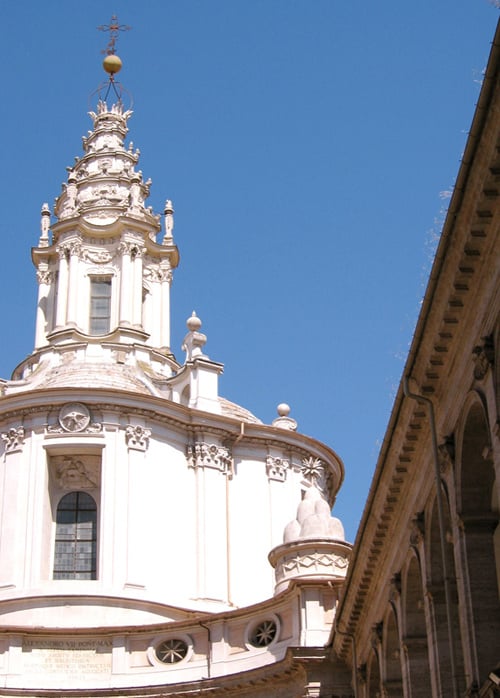
Spire and lantern, Sant’Ivo
Sant’Agostino Raphael
frescoed the prophet Isaiah (1512) on the third pillar on the right,
and Jacopo Sansovino provided the pregnant and venerated Madonna del Parto; but Sant’Agostino’s pride and joy is Caravaggio’s Madonna del Loreto
(1603–1606). The master’s strict realism balked at the tradition of
depicting Mary riding atop her miraculous flying house (which landed in
Loreto). The house is merely suggested by a travertine doorway and
flaking stucco wall where Mary, supporting her overly large Christ
child, is venerated by a pair of scandalously scruffy pilgrims.
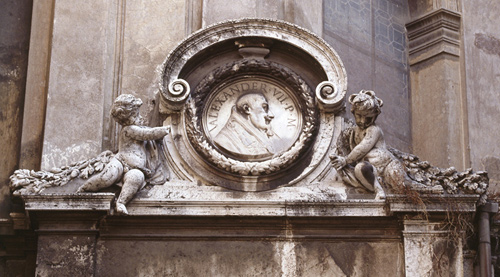
Santa Maria della Pace Baccio
Pontelli rebuilt this church for Pope Sixtus IV in 1480–84, but the
lovely and surprising façade (1656–7), its curved portico squeezed into a
tiny piazza, is a Baroque masterpiece by Pietro da Cortona. Raphael’s
first chapel on the right is frescoed with Sibyls (1514) influenced by the then recently unveiled Sistine ceiling .
Peruzzi decorated the chapel across the aisle and Bramante’s first job
in Rome was designing a cloister based on ancient examples. It now hosts
frequent concerts. Palazzo Altemps This
15th-century palace was overhauled in 1585 by Martino Longhi, who is
probably also responsible for the stucco and travertine courtyard
(previously attributed to Antonio da Sangallo the Younger or Peruzzi).
It now makes an excellent home to one wing of the Museo Nazionale
Romano, its frescoed rooms filled with ancient sculptures.
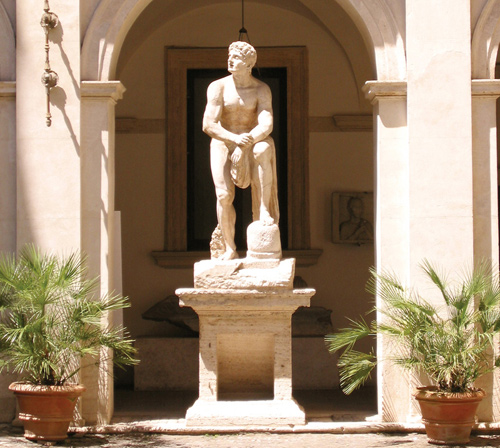
Pasquino That
this faceless, armless statue was part of “Menelaus with the body of
Patroclus” (a Roman copy of a Hellenistic group) is almost irrelevant.
Since this worn fragment took up its post here in 1501, it has been
Rome’s most vocal “Talking Statue”(see The Talking Statues).
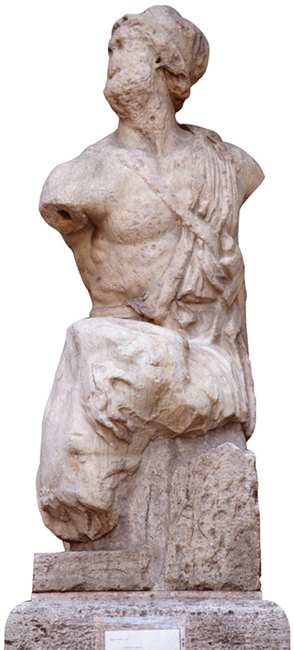
Pasquino, Piazza Pasquino
Palazzo Massimo alle Colonne This
masterpiece of Baldassare Peruzzi marks the transition of Roman
architecture from the High Renaissance of Bramante and Sangallo into the
theatrical experiments of Mannerism that would lead up to the Baroque.
The façade is curved for a reason; Peruzzi honoured Neo-Classical
precepts so much he wanted to preserve the arc of the Odeon of Domitian,
a small theatre incorporated into the south end of the emperor’s
stadium .
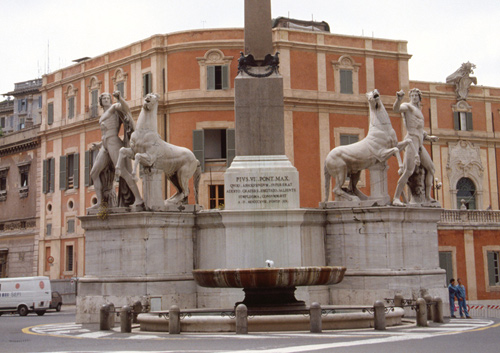
Palazzo Massimo alle Colonne
Palazzo Madama Based
around the 16th-century Medici Pope Leo X’s Renaissance palace, the
Baroque façade of unpointed brick and bold marble window frames was
added in the 17th century. Since 1870 it’s been the seat of Italy’s
Senate, so public admission is obviously limited.
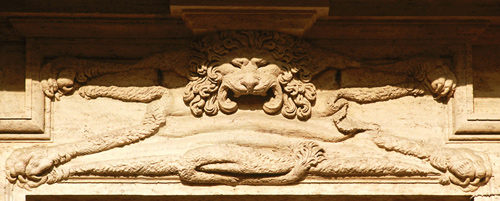
Stone relief, Palazzo Madama
|